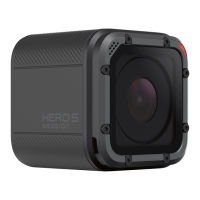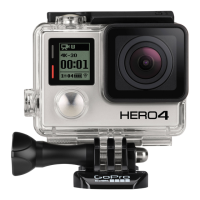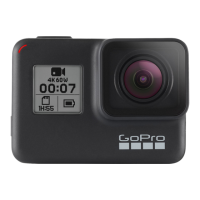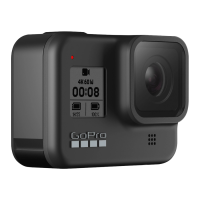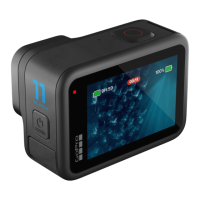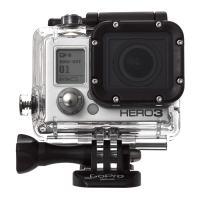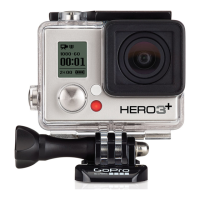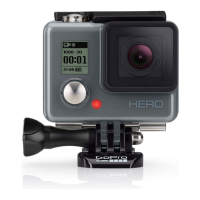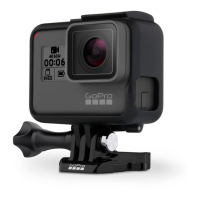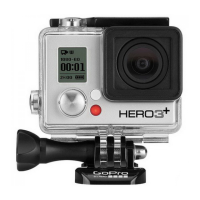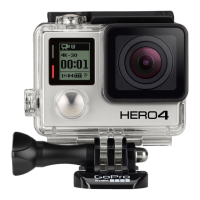Do you have a question about the GoPro HERO 5 BLACK and is the answer not in the manual?
Identifies the physical buttons, ports, and displays on the HERO5 Black camera.
Details the information displayed on the front camera status screen.
Details the touch display on the back of the camera.
Specifies the necessary types, classes, and capacity for microSD cards.
Provides instructions on how to reformat the microSD card for optimal performance.
Guides on how to charge the camera's battery before first use.
Instructions for connecting the camera to a power source for charging via USB-C.
Steps to download and install the latest software for optimal camera performance.
How to turn the camera on and off using the Mode button.
Details the information displayed on the front camera status screen.
Explains how to navigate the touch display using various gestures like tap and swipe.
Details common gestures for interacting with the touch display.
Introduces the three main camera modes: Video, Photo, and Time Lapse.
Instructions on how to select modes and capture settings using the touch screen.
How to change modes and settings using physical buttons, especially underwater.
Explains how to cycle through capture modes using the Mode button.
Visual map of settings and options available within Video mode.
Visual map of settings and options available within Photo mode.
Visual map of settings and options available within Time Lapse mode.
Steps to quickly capture video by pressing the Shutter button when the camera is off.
How to quickly capture time lapse photos by pressing and holding the Shutter button.
Instructions on how to disable the QuikCapture feature if it's not needed.
Using the touch display to preview, change modes, and capture video or photos.
Using voice commands to capture video and photos.
How to mark important moments during recording or playback.
Enabling and using voice commands to operate the camera.
Details action and mode commands for voice control.
Steps to select or change the voice control language.
How to access and view media directly on the camera's touch display.
Instructions on trimming video files to create short clips.
How to extract a single frame from a video as a still image.
Connecting the camera to an HDTV for playback using a micro HDMI cable.
Using the camera to record while connected to an HDTV for live preview.
Steps to download and connect the camera to the Capture app for the first time.
How to reconnect the camera to the Capture app after initial setup.
Transferring video and photos from the camera to a computer.
Using GoPro Plus to upload, edit, and share content from the cloud.
How to temporarily disable automatic uploads to GoPro Plus.
Changing the Wi-Fi network used for Auto Upload.
Details on the standard Video capture mode and its settings.
Explains how to capture photos at intervals while recording video.
How to record continuously and save only desired segments of video.
Explanation of video resolution (RES) and its impact on video quality.
Table detailing the best use cases for different video resolutions.
Explanation of FPS and its importance for capturing motion and slow-motion.
Information on 16:9 and 4:3 aspect ratios for video recording.
Explanation of FOV options (SuperView, Wide, Medium, Linear) and their best uses.
Detailed table of resolutions, FPS, FOV, screen resolution, and aspect ratio.
Continued table of video resolutions, FPS, FOV, screen resolution, and aspect ratio.
Cautionary notes about camera temperature and power consumption with high settings.
Explanation of the Interval setting for video capture and its options.
How to use video stabilization to smooth out footage from motion.
Setting to automatically adjust frame rate in low-light conditions for better exposure.
Options for manually controlling audio settings like wind filtering and stereo.
Introduction to Protune settings for advanced video customization.
Details on single or continuous photo capture and its settings.
How to capture photos in dim to dark light conditions.
Capturing up to 30 photos per second for fast-moving action.
Explanation of FOV options (Wide, Medium, Linear, Narrow) for photo capture.
Setting for burst photos to determine photos per second.
How to adjust shutter speed for Night Photo capture.
Retains detail in dark and bright areas for better exposure.
Capturing photos in RAW format (.gpr) alongside JPG for post-processing.
Protune availability and use in Photo mode.
Creating video from frames captured at specific intervals.
Capturing a series of photos at intervals to choose the best ones later.
Capturing photos at set intervals in low-light environments.
Settings for resolution and field of view specific to Time Lapse Video.
Explanation of FOV options for time lapse capture.
Setting the time between captured frames for time lapse.
Determining the capture rate for Night Lapse photos.
Adjusting shutter speed for Night Lapse Photo.
Protune availability for Time Lapse Photo and Night Lapse Photo.
Selecting an area to prioritize for exposure determination.
Manually setting and locking exposure levels for consistent results.
How to cancel exposure control settings and revert to automatic exposure.
Detailed explanation of Protune features and compatibility.
Adjusting the color profile (GoPro Color, Flat) for video or photos.
Optimizing color temperature for different lighting conditions.
Understanding ISO's effect on brightness and image noise in video.
Setting a range for ISO sensitivity to balance brightness and noise.
Adjusting shutter speed in Protune for video capture.
Affecting video/photo brightness to improve quality in contrasting light.
Controlling the detail quality in video footage or photos.
Creating a separate .wav file for audio processing.
Connecting external microphones or other audio components.
General guide to adjusting camera settings.
Manually setting or updating the camera's date and time.
Adjusting the volume of the camera's alerts and notifications.
Controlling which status lights blink on the camera.
Determining video orientation to prevent upside-down footage.
Setting regional frame rates to prevent flicker indoors.
Capturing location data for videos and photos.
Setting the camera's display language.
Meaning of temperature and file repair icons and camera actions.
Interpreting messages related to microSD card status (NO SD, FULL, SD ERR).
Clearing Wi-Fi connections and camera password.
Restoring most camera settings to their factory defaults.
Using The Frame and mounting buckle/thumb screw to attach the camera.
Steps to properly secure the camera within The Frame.
How to attach mounting buckles to various mounts.
Attaching the camera to curved and flat surfaces using adhesive mounts.
Best practices for applying adhesive mounts for secure attachment.
Compliance with laws and using tethers/floaty for water activities.
Steps to remove the side door for accessing ports.
Instructions for correctly reattaching the side door.
Tips and settings to extend the camera's battery life.
How to capture footage while the camera is plugged in for charging.
Precautions for storing and handling the camera's battery.
Information on how to safely dispose of lithium-ion batteries.
Troubleshooting steps if the camera does not turn on or respond.
Diagnosing and fixing choppy video playback on a computer.
Steps to retrieve or reset camera login credentials.
How to check the current software version of the camera.
Where to find the camera's unique serial number.
Information on how to reach GoPro Customer Support.
List of GoPro trademarks and their owners.
Information on country certifications and compliance.
Identifies the physical buttons, ports, and displays on the HERO5 Black camera.
Details the information displayed on the front camera status screen.
Details the touch display on the back of the camera.
Specifies the necessary types, classes, and capacity for microSD cards.
Provides instructions on how to reformat the microSD card for optimal performance.
Guides on how to charge the camera's battery before first use.
Instructions for connecting the camera to a power source for charging via USB-C.
Steps to download and install the latest software for optimal camera performance.
How to turn the camera on and off using the Mode button.
Details the information displayed on the front camera status screen.
Explains how to navigate the touch display using various gestures like tap and swipe.
Details common gestures for interacting with the touch display.
Introduces the three main camera modes: Video, Photo, and Time Lapse.
Instructions on how to select modes and capture settings using the touch screen.
How to change modes and settings using physical buttons, especially underwater.
Explains how to cycle through capture modes using the Mode button.
Visual map of settings and options available within Video mode.
Visual map of settings and options available within Photo mode.
Visual map of settings and options available within Time Lapse mode.
Steps to quickly capture video by pressing the Shutter button when the camera is off.
How to quickly capture time lapse photos by pressing and holding the Shutter button.
Instructions on how to disable the QuikCapture feature if it's not needed.
Using the touch display to preview, change modes, and capture video or photos.
Using voice commands to capture video and photos.
How to mark important moments during recording or playback.
Enabling and using voice commands to operate the camera.
Details action and mode commands for voice control.
Steps to select or change the voice control language.
How to access and view media directly on the camera's touch display.
Instructions on trimming video files to create short clips.
How to extract a single frame from a video as a still image.
Connecting the camera to an HDTV for playback using a micro HDMI cable.
Using the camera to record while connected to an HDTV for live preview.
Steps to download and connect the camera to the Capture app for the first time.
How to reconnect the camera to the Capture app after initial setup.
Transferring video and photos from the camera to a computer.
Using GoPro Plus to upload, edit, and share content from the cloud.
How to temporarily disable automatic uploads to GoPro Plus.
Changing the Wi-Fi network used for Auto Upload.
Details on the standard Video capture mode and its settings.
Explains how to capture photos at intervals while recording video.
How to record continuously and save only desired segments of video.
Explanation of video resolution (RES) and its impact on video quality.
Table detailing the best use cases for different video resolutions.
Explanation of FPS and its importance for capturing motion and slow-motion.
Information on 16:9 and 4:3 aspect ratios for video recording.
Explanation of FOV options (SuperView, Wide, Medium, Linear) and their best uses.
Detailed table of resolutions, FPS, FOV, screen resolution, and aspect ratio.
Continued table of video resolutions, FPS, FOV, screen resolution, and aspect ratio.
Cautionary notes about camera temperature and power consumption with high settings.
Explanation of the Interval setting for video capture and its options.
How to use video stabilization to smooth out footage from motion.
Setting to automatically adjust frame rate in low-light conditions for better exposure.
Options for manually controlling audio settings like wind filtering and stereo.
Introduction to Protune settings for advanced video customization.
Details on single or continuous photo capture and its settings.
How to capture photos in dim to dark light conditions.
Capturing up to 30 photos per second for fast-moving action.
Explanation of FOV options (Wide, Medium, Linear, Narrow) for photo capture.
Setting for burst photos to determine photos per second.
How to adjust shutter speed for Night Photo capture.
Retains detail in dark and bright areas for better exposure.
Capturing photos in RAW format (.gpr) alongside JPG for post-processing.
Protune availability and use in Photo mode.
Creating video from frames captured at specific intervals.
Capturing a series of photos at intervals to choose the best ones later.
Capturing photos at set intervals in low-light environments.
Settings for resolution and field of view specific to Time Lapse Video.
Explanation of FOV options for time lapse capture.
Setting the time between captured frames for time lapse.
Determining the capture rate for Night Lapse photos.
Adjusting shutter speed for Night Lapse Photo.
Protune availability for Time Lapse Photo and Night Lapse Photo.
Selecting an area to prioritize for exposure determination.
Manually setting and locking exposure levels for consistent results.
How to cancel exposure control settings and revert to automatic exposure.
Detailed explanation of Protune features and compatibility.
Adjusting the color profile (GoPro Color, Flat) for video or photos.
Optimizing color temperature for different lighting conditions.
Understanding ISO's effect on brightness and image noise in video.
Setting a range for ISO sensitivity to balance brightness and noise.
Adjusting shutter speed in Protune for video capture.
Affecting video/photo brightness to improve quality in contrasting light.
Controlling the detail quality in video footage or photos.
Creating a separate .wav file for audio processing.
Connecting external microphones or other audio components.
General guide to adjusting camera settings.
Manually setting or updating the camera's date and time.
Adjusting the volume of the camera's alerts and notifications.
Controlling which status lights blink on the camera.
Determining video orientation to prevent upside-down footage.
Setting regional frame rates to prevent flicker indoors.
Capturing location data for videos and photos.
Setting the camera's display language.
Meaning of temperature and file repair icons and camera actions.
Interpreting messages related to microSD card status (NO SD, FULL, SD ERR).
Clearing Wi-Fi connections and camera password.
Restoring most camera settings to their factory defaults.
Using The Frame and mounting buckle/thumb screw to attach the camera.
Steps to properly secure the camera within The Frame.
How to attach mounting buckles to various mounts.
Attaching the camera to curved and flat surfaces using adhesive mounts.
Best practices for applying adhesive mounts for secure attachment.
Compliance with laws and using tethers/floaty for water activities.
Steps to remove the side door for accessing ports.
Instructions for correctly reattaching the side door.
Tips and settings to extend the camera's battery life.
How to capture footage while the camera is plugged in for charging.
Precautions for storing and handling the camera's battery.
Information on how to safely dispose of lithium-ion batteries.
Troubleshooting steps if the camera does not turn on or respond.
Diagnosing and fixing choppy video playback on a computer.
Steps to retrieve or reset camera login credentials.
How to check the current software version of the camera.
Where to find the camera's unique serial number.
Information on how to reach GoPro Customer Support.
List of GoPro trademarks and their owners.
Information on country certifications and compliance.
| Camera Resolution | 12 MP |
|---|---|
| Touchscreen | Yes |
| Voice Control | Yes |
| GPS | Yes |
| Connectivity | Wi-Fi, Bluetooth |
| Image Sensor | 1/2.3" CMOS |
| Ports | USB-C, micro HDMI |
| Microphone | Stereo |
| Speaker | Yes |
| Storage | microSD (up to 128GB) |
| Video Resolution | 4K up to 30fps |
| Waterproof | Up to 10m (33ft) without a housing |
| Image Stabilization | Electronic |
| Battery | 1220mAh |
| Lens | Ultra Wide Angle Lens |
| Field of View | Wide, Medium, Narrow |
| ISO Range | 100-6400 (Video) |
| Weight | 118g |
